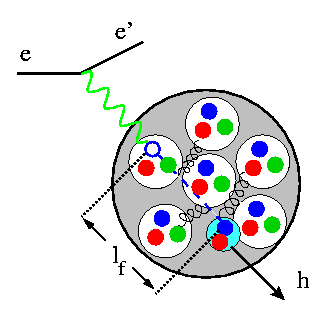
|
The Idea
Summary paper for the science reader.
The Measurement
The attenuation of pion, kaon, and proton production has been measured with krypton and deuterium targets showing an attenuation larger than seen in
nitrogen. Attenuation is studied as a function of hadron energy, virtual photon energy, and hadron transverse momentum, pt.
The data are from the 1999 unpolarized krypton running and now uses the RICH to identify pi, K, p.
The kinematics are similar to the extraction on the already published nitrogen:
Q^2 gt 1.0GeV^2, W^2 gt 4 GeV^2, x gt 0.06.
|
| HERMES Preliminary Released Plots: |
| Comparison of the hadron attenuation ratio R vs z for nitrogen and krypton. | *Color (eps) |
| Comparison of the hadron attenuation ratio R vs pt2 for nitrogen and krypton. | *Color (eps) |
|
| Comparison of the hadron attenuation ratio R vs nu for nitrogen and krypton. | *Color (eps)
|
|
| Comparison of the hadron attenuation ratio R vs nu for nitrogen and krypton in comparison with data from EMC and SLAC. | *Color (eps)
|
| Comparison of the hadron and pion attenuation ratio R vs nu for positive and negative charges (kyrpton). | *Color (eps) |
|
|
| Nuclear attenuation on krypton, normalized to the deuterium: |
|
| Data plotted as a function of nu for charged pions, kaons, protons and anti-protons. | *Colour (eps) |
| Data plotted as a function of z for charged pions, kaons, protons and anti-protons. | *Colour (eps) |
|
Cuts: Q2>1 GeV2, x>0.02, W2>4 GeV2, y<0.85, 15>p>2.5 GeV for pions and kaons.
15>p>4 GeV for protons and anti-protons. |
